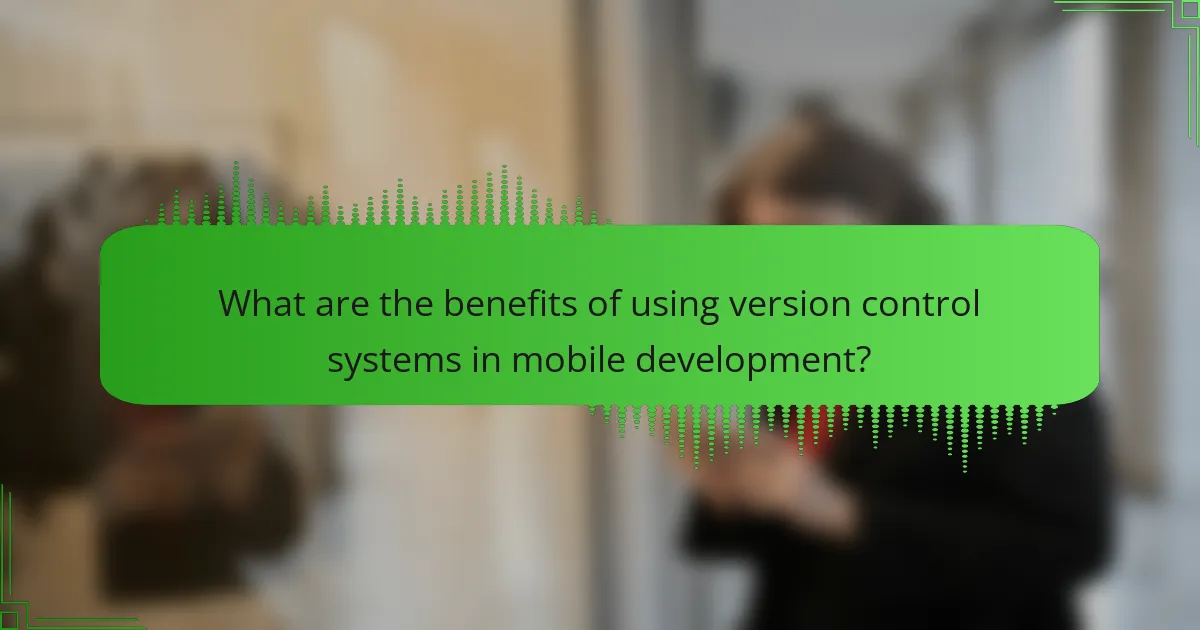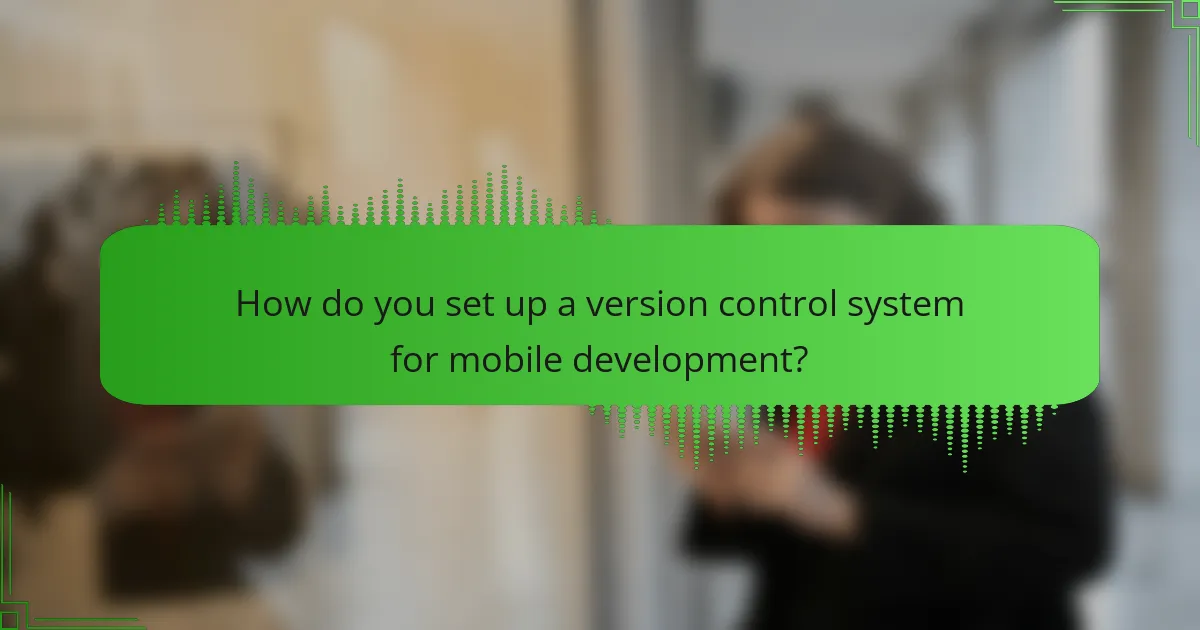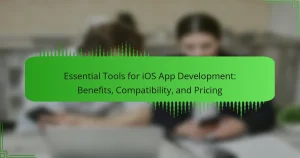Version control systems are essential tools for mobile development, with Git recognized as the leading option due to its powerful branching and merging capabilities. This article provides an overview of the best version control systems, including Git, Subversion (SVN), and Mercurial, highlighting their features and benefits for collaborative software development. It discusses how these systems enhance productivity, maintain a history of changes, and facilitate debugging. Additionally, the article outlines the setup process for implementing a version control system, specifically focusing on Git, to ensure effective project management in mobile development.

What are the best version control systems for mobile development?
Git is the best version control system for mobile development. It offers robust branching and merging capabilities. Git is widely used in the software development industry. It allows multiple developers to collaborate efficiently. GitHub and GitLab enhance Git’s functionality with hosting and project management features. Subversion (SVN) is another popular option, especially for larger teams. It provides centralized version control, which can simplify management. Mercurial is also effective, with a focus on ease of use. Each of these systems supports mobile development workflows effectively.
How do version control systems benefit mobile development?
Version control systems benefit mobile development by enabling efficient collaboration among developers. They allow multiple team members to work on the same project simultaneously without overwriting each other’s changes. This is crucial in mobile development, where teams often consist of developers, designers, and testers.
Version control systems also track changes made to the codebase. This feature helps in identifying when and why specific changes were made. It simplifies the process of reverting to previous versions if bugs are introduced.
Moreover, they facilitate code reviews and maintain a history of project evolution. This history can be invaluable for onboarding new team members. According to a study by GitHub, teams using version control systems report a 30% increase in productivity due to streamlined workflows.
In summary, version control systems enhance collaboration, track changes, and improve productivity in mobile development.
What specific challenges in mobile development do version control systems address?
Version control systems address several specific challenges in mobile development. They help manage code changes made by multiple developers simultaneously. This prevents conflicts and ensures that the latest version is always available. Version control systems also provide a history of changes. This allows developers to track modifications and revert to previous versions if needed. Additionally, they facilitate collaboration among remote teams. By using branches, developers can work on features independently without disrupting the main codebase. Furthermore, version control systems enhance code quality through code reviews. This process helps identify bugs and improve overall functionality. Overall, they streamline the development workflow and improve project management efficiency.
How can version control improve collaboration among mobile development teams?
Version control improves collaboration among mobile development teams by enabling multiple developers to work on the same codebase simultaneously. It allows team members to track changes, manage revisions, and resolve conflicts efficiently. With version control, developers can create branches for new features or bug fixes without affecting the main codebase. This isolation promotes experimentation and reduces the risk of introducing errors. Additionally, version control systems maintain a history of all changes, which facilitates code reviews and accountability. According to a study by GitHub, teams using version control experience a 50% increase in productivity due to better collaboration and streamlined workflows.
What features should you look for in a version control system for mobile development?
A version control system for mobile development should include features like branching, merging, and collaboration tools. Branching allows developers to work on features independently without affecting the main codebase. Merging integrates changes from different branches, ensuring that all updates are combined effectively. Collaboration tools facilitate communication among team members, streamlining the development process. Additionally, a robust version history tracks changes, making it easy to revert to previous versions if needed. Support for large binary files is also essential, as mobile apps often include images and other media. Integration with continuous integration and deployment (CI/CD) systems enhances the development workflow. Finally, user-friendly interfaces and strong security features are important for a smooth experience. These features collectively contribute to efficient mobile app development, as confirmed by industry standards and developer preferences.
Which functionalities are essential for managing mobile codebases?
Essential functionalities for managing mobile codebases include version control, collaboration tools, and automated testing. Version control systems track changes in code, enabling developers to manage updates efficiently. Collaboration tools facilitate communication among team members, ensuring cohesive development. Automated testing allows for continuous integration and delivery, improving code quality and reducing errors. These functionalities are crucial for maintaining code integrity and enhancing team productivity.
How do different version control systems compare in terms of usability?
Different version control systems vary significantly in usability. Git is widely regarded for its flexibility and branching capabilities, making it a favorite among developers. However, its command-line interface can be intimidating for beginners. Subversion (SVN) offers a more straightforward model, focusing on centralized version control, which may be easier for new users to grasp. Mercurial provides a balance between Git’s complexity and SVN’s simplicity, with a user-friendly interface. Additionally, tools like GitHub and GitLab enhance usability by providing graphical interfaces and collaboration features. Research indicates that user satisfaction with a system often correlates with its learning curve and community support, emphasizing the importance of documentation and tutorials.
What are the top version control systems recommended for mobile development?
Git is the top version control system recommended for mobile development. It is widely used due to its distributed nature and branching capabilities. Git enables multiple developers to work on the same project without conflicts. Another recommended system is Subversion (SVN), known for its centralized version control. SVN is suitable for projects requiring strict access controls. Mercurial is also popular, offering similar features to Git but with a simpler interface. Additionally, Bitbucket and GitHub provide hosting for Git repositories, enhancing collaboration. These systems are favored for their reliability and robust community support.
What are the unique attributes of Git for mobile development?
Git offers several unique attributes for mobile development. Its distributed version control allows multiple developers to work offline and merge changes later. Branching and merging capabilities enable experimentation without affecting the main codebase. Git’s performance is optimized for large projects, which is crucial for mobile applications. The staging area provides granular control over commits, allowing developers to manage changes effectively. Additionally, Git integrates seamlessly with various platforms like GitHub and Bitbucket, enhancing collaboration. Its extensive community support ensures access to resources and troubleshooting help. These attributes make Git a preferred choice for mobile development teams.
How does Subversion cater to mobile development needs?
Subversion caters to mobile development needs by providing a centralized version control system. It allows developers to manage changes to code efficiently. Subversion supports branching and merging, which is essential for mobile application development. This feature enables teams to work on different features without conflicts. Additionally, Subversion offers robust access control mechanisms. These mechanisms ensure that only authorized users can modify the codebase. Subversion also maintains a complete history of changes, facilitating easy rollback if necessary. This historical data aids in debugging and tracking issues over time. Overall, Subversion’s features align well with the collaborative and iterative nature of mobile development.
What advantages does Mercurial offer for mobile developers?
Mercurial offers several advantages for mobile developers. It provides a distributed version control system, enabling developers to work offline. This feature is crucial for mobile developers who may not always have stable internet access. Mercurial also supports branching and merging, allowing teams to manage multiple features simultaneously. This capability enhances collaboration among developers. Additionally, Mercurial has a simple command-line interface, making it user-friendly for developers of all skill levels. Its performance is optimized for large projects, ensuring quick operations even with extensive codebases. Mercurial’s efficient handling of binary files is another benefit, which is particularly useful in mobile development where media assets are common.

What are the benefits of using version control systems in mobile development?
Version control systems provide significant benefits in mobile development. They enable collaboration among multiple developers, allowing simultaneous work on the same project. This reduces conflicts and streamlines the integration of different code contributions. Version control systems also maintain a history of changes, making it easy to track modifications over time. This feature aids in identifying when bugs were introduced and facilitates easier debugging. Additionally, they support branching and merging, allowing developers to experiment without affecting the main codebase. According to a survey by GitHub, 83% of developers reported improved collaboration when using version control systems. Overall, these systems enhance productivity, code quality, and project management in mobile development.
How does version control enhance code quality in mobile apps?
Version control enhances code quality in mobile apps by enabling systematic tracking of changes. It allows developers to collaborate effectively and maintain a history of modifications. This history aids in identifying and resolving bugs quickly. Version control systems also support branching, which enables experimentation without affecting the main codebase. Developers can test new features independently and merge them only when they are stable. Furthermore, version control facilitates code reviews, promoting best practices and reducing errors. Studies show that teams using version control report higher code quality and fewer defects. These benefits collectively contribute to the overall reliability and maintainability of mobile applications.
What role does version control play in bug tracking and resolution?
Version control is essential for effective bug tracking and resolution. It allows developers to track changes in code over time. Each change is recorded with a unique identifier, making it easy to identify when a bug was introduced. This historical record helps in pinpointing the exact version of the code that contains the bug. Additionally, version control systems enable collaborative debugging. Multiple team members can work on the same codebase without overwriting each other’s changes. They can also create branches to isolate bug fixes from the main code. Once a bug is resolved, the fix can be merged back into the main branch seamlessly. This process minimizes disruption to ongoing development. Overall, version control enhances the efficiency and accuracy of bug tracking and resolution in software development.
How can version control facilitate continuous integration in mobile projects?
Version control facilitates continuous integration in mobile projects by enabling collaborative development and code management. It allows multiple developers to work on the same codebase simultaneously without conflicts. Each change is tracked, making it easy to identify and resolve issues quickly. Version control systems, like Git, support branching and merging, which are essential for integrating features and fixes. Automated builds can be triggered upon code commits, ensuring that new changes are tested immediately. This process reduces integration problems and improves code quality. According to a study by Duvall et al. in “Continuous Integration: Improving Software Quality and Reducing Risk,” organizations using version control with CI practices report higher deployment success rates and faster release cycles.
Why is collaboration important in mobile development?
Collaboration is crucial in mobile development because it enhances team efficiency and innovation. Effective collaboration allows developers, designers, and stakeholders to share insights and skills. This collective approach leads to higher-quality applications. A study by the Project Management Institute shows that effective collaboration can improve project success rates by 20-30%. Furthermore, collaboration fosters better problem-solving through diverse perspectives. It also accelerates the development process by allowing parallel work on different components. Overall, collaboration is essential for meeting deadlines and achieving project goals in mobile development.
How does version control support teamwork among developers?
Version control supports teamwork among developers by enabling collaboration on code changes. It allows multiple developers to work on the same project simultaneously. Developers can track changes made to the codebase over time. This tracking helps in identifying who made specific changes and when. It also facilitates merging different contributions into a unified codebase. Version control systems like Git provide branching features. Branching allows developers to create separate lines of development for features or fixes. This separation minimizes conflicts and enhances productivity. Additionally, version control maintains a history of changes. This history is crucial for reverting to previous versions if needed. Overall, version control is essential for effective teamwork in software development.
What are the implications of version control on project timelines?
Version control significantly impacts project timelines by enhancing collaboration and reducing errors. It allows multiple team members to work simultaneously on different parts of a project. This parallel workflow accelerates development. Version control systems also provide a history of changes, making it easier to track progress and revert to previous versions if necessary. This capability minimizes downtime caused by mistakes. Additionally, version control facilitates better project management through clear documentation of changes. According to a study by the IEEE, teams using version control report a 30% reduction in project delays. This statistic underscores the effectiveness of version control in maintaining project schedules.

How do you set up a version control system for mobile development?
To set up a version control system for mobile development, first choose a version control system, such as Git. Install the version control software on your development environment. Initialize a new repository in your mobile project directory using the command `git init`. Next, add your project files to the repository with `git add .`. Commit the changes to the repository using `git commit -m “Initial commit”`. Create a remote repository on platforms like GitHub or GitLab. Link your local repository to the remote one with `git remote add origin
What are the steps to install and configure a version control system?
To install and configure a version control system, follow these steps. First, choose a version control system like Git or Subversion. Download the installation package from the official website. Run the installer and follow the prompts to complete the installation. After installation, open the command line interface or terminal. Configure your user name and email with the commands ‘git config –global user.name “Your Name”‘ and ‘git config –global user.email “[email protected]”‘. Initialize a new repository in your project directory using ‘git init’. Finally, add files to the staging area with ‘git add .’ and commit changes using ‘git commit -m “Initial commit”‘.
How do you initialize a new repository for a mobile project?
To initialize a new repository for a mobile project, use Git as the version control system. First, navigate to your project directory in the terminal. Then, execute the command ‘git init’ to create a new Git repository. This command sets up the necessary files for tracking changes. Next, add your project files using ‘git add .’ to stage them for commit. After staging, commit the files with ‘git commit -m “Initial commit”‘ to save the changes. This process establishes the repository and prepares it for version control. Git is widely used in mobile development for its efficiency and collaboration features.
What best practices should be followed during the setup process?
During the setup process of version control systems for mobile development, it is crucial to follow several best practices. First, ensure that you choose a suitable version control system that meets your project’s needs, such as Git or Mercurial. Next, establish a clear branching strategy to manage features, bugs, and releases effectively. Implement a consistent commit message format to enhance clarity and traceability. Additionally, configure access controls to secure your repository and manage permissions appropriately. Regularly back up your repository to prevent data loss, and automate testing and deployment processes to streamline workflows. These practices lead to improved collaboration and reduce the likelihood of errors during development.
How can you maintain and manage your version control system effectively?
To maintain and manage your version control system effectively, implement regular updates and backups. Frequent updates ensure that you are using the latest features and security patches. Backups protect your work from data loss. Establish a clear branching strategy for collaboration. This helps avoid conflicts during development. Regularly review commit messages for clarity and relevance. This practice aids in understanding project history. Utilize tags for marking release points. Tags provide easy reference to specific versions. Conduct periodic audits of your repository to clean up unused branches. This keeps the repository organized. Train your team on best practices for version control. Well-informed team members contribute to a smoother workflow.
What strategies can help in organizing branches and tags in mobile development?
Use a clear naming convention for branches and tags in mobile development. This strategy enhances clarity and understanding among team members. For instance, use prefixes like ‘feature/’, ‘bugfix/’, and ‘release/’ to categorize branches effectively. Implementing a consistent versioning system, such as Semantic Versioning (SemVer), aids in managing releases and updates systematically. Regularly merging branches into the main branch minimizes conflicts and keeps the codebase stable. Additionally, using tags for version releases provides a snapshot of the code at specific points in time. This practice simplifies tracking changes and facilitates easier rollbacks if necessary. Overall, these strategies promote better organization and collaboration within mobile development teams.
How do you handle merges and resolve conflicts in a mobile codebase?
To handle merges and resolve conflicts in a mobile codebase, use a systematic approach. First, ensure that all team members frequently pull the latest changes from the main branch. This minimizes divergence in the codebase. When a merge conflict occurs, identify the conflicting files using version control tools. Review the differences in the code and understand the changes made by both parties.
Next, manually resolve the conflict by editing the conflicting sections in the code. After resolving, test the code to ensure functionality is maintained. Commit the resolved changes with a clear message indicating the resolution. Regularly performing code reviews can help catch potential conflicts early. Following these practices can lead to smoother merges and fewer conflicts.
What troubleshooting tips can help with version control issues in mobile development?
Use clear commit messages to avoid confusion. Ensure all team members follow a consistent naming convention. Regularly merge changes to minimize conflicts. Pull the latest changes frequently to stay updated. Use branches for new features to isolate changes. Resolve conflicts immediately when they arise. Test thoroughly after merges to catch issues early. Document the workflow for all team members to follow.
How do you recover lost commits or resolve common errors?
To recover lost commits or resolve common errors, use the Git command `git reflog`. This command shows a log of all actions taken in the repository. Identify the commit you want to recover from the reflog. Then, use `git checkout
What are the best practices for backup and recovery in version control systems?
Regularly commit changes to ensure data is saved frequently. Each commit should capture a logical unit of work. Use branching strategies to isolate features or fixes. This allows for safer experimentation. Implement automated backups to a secure location. Scheduled backups minimize the risk of data loss. Test recovery procedures regularly to ensure they work effectively. Document the backup and recovery process for team reference. Use tools like Git hooks to automate backup tasks. These practices enhance data integrity and reduce downtime during recovery.
The main entity of this article is version control systems specifically tailored for mobile development. It provides an overview of the best version control systems, including Git, Subversion (SVN), and Mercurial, highlighting their unique attributes and functionalities. The article discusses the benefits of using version control systems in mobile development, such as enhanced collaboration, improved code quality, and streamlined project management. Additionally, it outlines best practices for setting up, maintaining, and managing these systems effectively, ensuring that teams can maximize their productivity and minimize errors during the development process.


